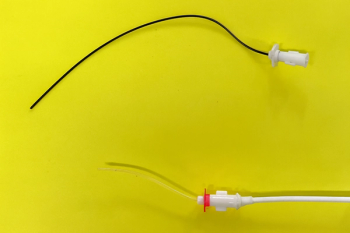
Updates in outpatient management of chronic kidney disease (Proceedings)
There are four stages of chronic kidney disease (CKD) in The International Renal Interest Society (IRIS) staging system.
Staging of chronic kidney disease
There are four stages of chronic kidney disease (CKD) in The International Renal Interest Society (IRIS) staging system. The four stages are based on serum creatinine, with two substages based on hypertension and proteinuria. The risk associated with hypertension is stratified and further categorized if hypertensive complications are present. A urine protein:creatinine ratio (UPC) < 0.2 is non-proteinuric, 0.2-0.4 is borderline, and > 0.4 is proteinuric.
Nutrition
In one study of 45 cats with Stage II or III CKD, none of the cats fed a renal diet (Hill's K/D) died of renal causes or had a uremic crisis during the 2 year study, compared to 22% renal-related deaths and 26% suffering a uremic crisis in the cats fed a maintenance diet. In a canine CKD study, dogs eating a renal diet lived twice as long as dogs eating a maintenance diet. A renal diet should have a restricted quantity of high biologic value protein, and should be restricted in phosphorus. Excessive salt restriction may promote activation of the renin-angiotensin-aldosterone system and inappropriate kaliuriesis leading to hypokalemia, without beneficial effect on blood pressure. Decreasing the ratio of omega-6 to omega-3 essential fatty acids may have some renoprotective effect; this area deserves further study. Phosphate restriction in the diet will help reduce renal secondary hyperparathyroidism and renal mineralization, and can thus help slow progression and provide a better quality of life.
Anorexia
Over 40% of cats with CKD have a diminished appetite. Several drugs have been used to stimulate appetite, including diazepam, oxazepam, and cyproheptadine. A new drug, mirtazapine (Remeron), has been used anecdotally to increase appetite and control nausea. A dose reduction is recommended because it is partially excreted by the kidney, and serotonin syndrome may occur as a side effect. No studies on its use in cats with CKD have been published.
Any diet change should usually be delayed until the pet is eating well at home. Changing to a renal diet may take 3-4 weeks, and weekly phone calls help to encourage clients to remain compliant.
Measuring proteinuria
Multiple methods are available to assess proteinuria. The urine dipstick is unreliable for detecting proteinuria, with a sensitivity of 37% and specificity of 75%. Many urine samples with a positive dipstick reading (trace or higher) may have a urine protein:creatinine ratio (UPC) less than 0.5. A microalbuminuria test (Heska Corp) was positive in 110 out of 324 feline urine samples; 16 of the 324 had a UPC over 0.4. There does not appear to be an advantage to urine albumin:creatinine ratio compared to urine protein:creatinine ratio. In dogs, one UPC measurement is adequate to reliably estimate UPC when < 4. When monitoring changes in UPC over time, a change of 80% is needed to demonstrate a significant difference when the UPC is around 0.5.
Proteinuria and antiproteinuric drugs
Several studies have found that proteinuria is associated with a shorter survival time in dogs and cats with CKD. Cats with a urine protein:creatinine ratio over 0.4 had a 4 times higher risk of death than cats with a UPC < 0.2. One study found an increased risk of death in cats with a UPC between 0.2-0.4 (compared to < 0.2), but this finding was not consistent with results of another study. Significant proteinuria (UPC > 0.4) is not common in cats with CKD. About 50-66% of cats with CKD have a UPC < 0.2. Benazepril, an angiotensin converting enzyme inhibitor (ACEi), decreases the magnitude of proteinuria. A randomized placebo-controlled study of almost 200 cats with CKD (Stages II-IV) did not find a survival advantage to benazepril compared to placebo when followed for 3 years. A subgroup analysis of cats with a UPC > 1 also failed to show significant difference in survival between benazepril and placebo, but included only 13 cats. In another study of 60 cats with CKD (Stages II-IV) followed for 6 months, there was no survival advantage in the benazepril group compared to placebo. There was no difference in creatinine between benazepril and placebo groups in either study. In contrast, a study of 6 cats with Stage II-III CKD treated with benazepril showed a decrease in serum creatinine (from 3.4 to 2.5 mg/dl) after 12 weeks of therapy. A similar decline in creatinine was not seen in the control group. The cats in that study had urine dipstick measurements of 2+ to 3+ without UPC measurement. I routinely monitor UPC in cats with CKD, and treat those with a UPC over 0.4 with benazepril.
Proteinuria is more common in dogs with CKD compared to cats, with over half of dogs in one study having a UPC over 1. The relative risk of death or uremic crisis was 3 times higher in dogs with a UPC over 1, and the relative risk of adverse outcome was about 1.5 times higher for every 1 unit increase in UPC. ACEi are effective in decreasing proteinuria.
Hypertension
About 1/3 of dogs and cats with CKD have hypertension. A calcium channel antagonist, amlodipine (Norvasc), is commonly used to treat hypertension in cats. In one study, the starting dose of 0.625 mg per cat once daily was increased to 1.25 mg/cat in 50% of cats to achieve the target systolic blood pressure of less than 160 mmHg. Hypertension is associated with proteinuria, and control of hypertension with amlodipine decreased proteinuria, with more dramatic decreases in cats with higher levels of proteinuria. Hypertension does not impact survival in cats with CKD. This is in sharp contrast to the effects of hypertension in dogs, in which a systolic blood pressure over 160 mmHg is associated with a 3 times higher relative risk of death or uremic crisis, and with faster progression of azotemia. Amlodipine is a vasodilator. If systemic blood pressure is not adequately controlled by amlodipine as a sole agent, there is concern that the preferential afferent arteriole dilation may increase glomerular hypertension, which may hasten deterioration of renal function. Addition of an ACEi as an antihypertensive medication can be considered in that setting.
In dogs with hypertension and proteinuria, an ACEi is a reasonable first choice antihypertensive drug, although addition of a second or third drug, such as a calcium channel antagonist, is frequently needed.
Nephrolithiasis and ureterolithiasis
About half of cats diagnosed with CKD in a recent study had evidence of nephrolithiasis, although nephrolithiasis did not affect survival or progression of CKD. Ureterolithiasis is also increasing in incidence in almost alarming fashion. Over 95% of nephroliths and ureteroliths in cats are composed of calcium oxalate (predominantly) or calcium phosphate. A common presentation is an acutely uremic cat with one large obstructed kidney and a contralaterally small kidney. Ureteroliths may spontaneously pass into the bladder over a few days. If they do not, surgical removal is indicated. The 2 year survival rate for cats treated surgically is around 90%, compared to 66% with medical management.
Medications
Antiemetics
Centrally acting antiemetics like metoclopramide (Reglan) can be used as needed for nausea or vomiting, at a dose of 0.1 to 0.5 mg/kg PO TID. Ondansetron (Zofran, 0.1 mg/kg PO BID-TID, 0.1-0.3 mg/kg IV BID-TID) or dolasetron (Anzemat, 0.5 mg/kg PO, SC, IV SID) have also been used with good results. Meropitant (Cerenia) is a recently released drug approved for use in dogs that decreased vomiting in dogs with a variety of diseases including renal failure. It appeared to be twice as effective as metoclopramide. Limited information is available on its use in cats.
Phosphate binders
Because the ability to excrete phosphate diminishes with decreased GFR, hyperphosphatemia is commonly seen with CRF. Because methods to increase excretion (i.e., increasing GFR by fluid therapy) are usually of limited efficiency, phosphate binders are used to prevent absorption of phosphorous that is ingested with meals. Salts of aluminum (aluminum hydroxide, aluminum carbonate, aluminum oxide) are available as over the counter antacids. Liquid forms are more effective than tablets or capsules; powdered forms may be added to the food and are reported to be tasteless. Excessive absorption of aluminum can lead to toxicity, including anemia and neurologic symptoms, but this seems uncommon in veterinary practice. Calcium based phosphate binders avoid the aluminum toxicity issue, but predispose the patient to hypercalcemia. Of the calcium based products available, calcium acetate is superior due to reduced risk of hypercalcemia with retained efficacy. Dosage of phosphate binders should be titrated based on serum phosphate concentration, but 30-90 mg/kg/day is a starting dose for the aluminum containing preparations. Epikitin is a veterinary product composed of chitosan and calcium carbonate. In a study of 6 cats, serum phosphorous concentration decreased without change in the serum calcium concentration. Lanthanum carbonate is an effective phosphate binder, but the veterinary formulation (Renalzin) is not available in the USA, although the human formulation (Fosrenol) is available. Experience with sevalemer hydrochloride (Renagel) and sevalemer carbonate (Renvala) in animals is limited.
The goals of phosphate control are to maintain a serum phosphorus concentration less than 4.5 mg/dl for stage II CKD, under 5.0 mg/dl for stage III, and under 6.0 mg/dl for stage IV CKD patients.
Calcium metabolism
Renal secondary hyperparathyroidism occurs due to a variety of influences, including hypocalcemia induced by hyperphosphatemia, insensitivity of the parathyroid gland to feedback, and a decrease in the ability of the kidney to produce calcitriol. Administration of calcitriol helps reverse renal secondary hyperparathyroidism in dogs, and increases survival to 365 days, compared to 250 days in dogs treated with placebo. In cats, however, parathyroid hormone concentrations did not change after 14 days of calcitriol therapy. Until evidence of benefit is available in cats, I do not recommend this therapy in this species.
Intestinal probiotics
Azodyl is a product composed of bacteria selected due to their ability to metabolize uremic toxins as nutrients. Oral administration of an enteric coated capsule allows delivery of the bacteria to the colon, where they "trap" toxins for excretion in the stool. A study in 7 cats showed a mean decrease in BUN of 5 mg/dl and a mean decrease in creatinine of 0.4 mg/dl after 2 months of therapy.
Anemia
Anemia affects about 10% of cats with CKD at diagnosis and over 50% prior to death. Erythropoiesis Stimulating Agents: The anemia of CKD can be treated with human recombinant DNA erythropoietin (Epogen®, ProCrit®) but about 25% of dogs and cats will develop antiEpogen antibodies leading to pure red cell aplasia. A modified erythropoietin product, darbepoetin (Aranesp), is available. Because there are more carbohydrate groups shielding the protein backbone, it is theoretically less immunogenic. There are no published reports, but anecdotal information suggests a lower rate of pure red cell aplasia. It is more expensive than Epogen or Procrit, but is given less frequently (weekly to every third week). Iron: In treating anemia of CKD, iron supplementation should not be overlooked, as many patients are iron deficient. Oral iron is poorly absorbed but is readily available in many multi-vitamin preparations. Iron dextran can be administered intramuscularly monthly. During the initial stages of erythropoiesis stimulating agent treatment (whether erythropoietin or darbepoetin), iron utilization for red cell production may be extensive, and monitoring iron stores will help direct iron supplementation. Serum iron concentration may be decreased by iron deficiency or by inflammation; conversely, ferritin may be increased by inflammation. The percent of iron saturation (calculated by serum iron divided by total iron binding capacity) should be over 33%.
Other issues
Slowing progression of CKD
The use of angiotensin converting enzyme inhibitors (ACEi) decreases proteinuria and may prolong survival in proteinuric dogs. Studies in dogs and cats with CKD have shown a decrease in BUN and creatinine and an increase in glomerular filtration rate within 30 days of starting benazepril.
Role of vaccination
The FVRCP vaccine commonly administered to cats is produced from Crandell Rees feline kidney cells. Parenteral injection of Crandell Rees kidney cell lysate in amounts similar to that found in vaccine preparations were associated with interstitial nephritis at 2 weeks post injection. Previous studies at 6 weeks post injection showed no inflammation.
Monitoring
Frequency of monitoring depends on the clinical condition of the patient. If there are ever questions about the cat's stability or a change in the status, a recheck is always in order. I have created a set of arbitrary guidelines for monitoring. Cats that are more severely affected for the stage are monitored at the more frequent interval for the stage. Routine monitoring may detect problems before clinical signs are present, and early treatment may prevent or ameliorate clinical signs.
Prognosis of CKD
Survival times are related to the IRIS stage of disease in stable CKD. The degree of azotemia in a decompensated cat that requires hospitalization may be misleading in determining prognosis, as 30% of cats presenting with a creatinine over 5 mg/dl will be categorized in a lower IRIS stage after rehydration and stabilization. Median survival time for cats with Stage IIb was 763 days, Stage III was 548 day, and Stage IV was 97 days. Cats with Stage IIb CKD have a 40% chance of dying of CKD (vs other disease process), whereas cats with Stage IV CKD have a 93% chance of dying of CKD. The presence of anemia is associated with shorter survival times, but anemia is correlated to increased creatinine concentration. Systemic acidosis did not predict decompensation, although acidosis is more common with severe uremia. The effects of proteinuria on survival are discussed above.
References
Elliott, J., H. M. Syme, et al. (2003). "Assessment of acid-base status of cats with naturally occuriing chronic renal failure." J Small Anim Pract 44: 65-70.
King, J., S. Tasker, et al. (2007). "Prognostic factors in cats with chronic kidney disease." J Vet Intern Med 21(5): 906-16.
King, J. N., D. A. Gunn-Moore, et al. (2006). "Tolerability and Efficacy of Benazepril in Cats with Chronic Kidney Disease." J Vet Intern Med 20: 1054-1064.
Kuwahara, Y., Y. Ohba, et al. (2006). "Association of laboratory data and death within one month in cats with chronic renal failure." J Small Anim Pract 47: 446-450.
Kyles, A. E., E. M. Hardie, et al. (2005). "Management and outcome of cats with ureteral calculi: 153 cases (1984-2002)." J Am Vet Med Assoc 226(6): 937-944.
Lappin, M. R., R. J. Basaraba, et al. (2006). "Interstitial nephritis in cats inoculated with Crandell Rees feline kidney celly lysate." J Feline Med Surg 8: 353-356.
Mizutani, H., H. Koyama, et al. (2006). "Evaluation of the Clinical Efficacy of Benazepril in the Treatment of Chronic Renal Insufficiency in Cats." J Vet Intern Med 20: 1074-1079.
Ross, S. J., C. A. Osborne, et al. (2006). "Clinical evaluation of dietary modification for treatment of spontaneous chronic kidney disease in cats." J Am Vet Med Assoc 229: 949-957.
Syme, H. M., P. J. Markwell, et al. (2006). "Survival of Cats with Naturally Occurring Chronic Renal Failure Is Related to Severity of Proteinuria." J Vet Intern Med 20: 528-535.
Tenhundfeld, J, P. Wefstaedt, et al. (2009). "A randomized controlled clinical trial of the use of benazepril and heparin for the treatment of chronic kidney disease in dogs." J Am Vet Med Assoc 234(8):1031-1037.
Watanabe, T. and M. Mishina (2007). "Effects of benazepril hydrochloride in cats with experimentally induced or spontaneously occurring chronic renal failure." J Vet Med Sci 69(10): 1015-23.
Newsletter
From exam room tips to practice management insights, get trusted veterinary news delivered straight to your inbox—subscribe to dvm360.



